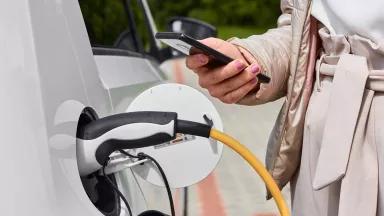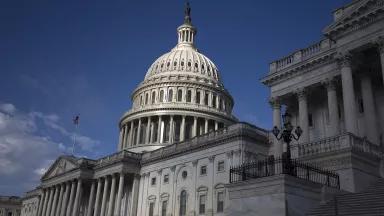Let’s Finish the Job for Cleaner Cars
While much clean car progress is being made, it is critical that the Biden administration and EPA Administrator Michael Regan finish the job and set the strongest possible standards for clean vehicles.

A young man plugging in his electric car at a charging station.
Simon Skafar/Getty Images
This blog was coauthored by Sarah Street, communications assistant, federal media communications, NRDC
Thanks to historic federal investments and evolving consumer preferences, automakers are transitioning toward electric cars and trucks that don’t pollute. But to ensure we stay on this road to clean air and a safer climate, we need the Biden administration to finish the job by enacting strong federal clean car standards.
On his first day in office, President Biden made the transition to cleaner cars a principal goal, and Congress has backed that effort with massive investments through the Inflation Reduction Act and Bipartisan Infrastructure Law. With the industry already moving toward electric vehicles and the support from federal tax incentives, it’s clear that the U.S. Environmental Protection Agency (EPA) can and must put in place standards that will cut tailpipe pollution 75% by 2030. Strong standards like that would save consumers money at the pump, protect public health and the climate, and grow our domestic manufacturing base and jobs. Given these benefits, the EPA must finalize these standards before the end of this year.
Over the past five decades, clean car and fuel economy standards have been the most significant actions the United States has taken to reduce both reliance on oil and consumer “pain at the pump.” As a result of these standards, a new SUV today can drive as far on a gallon of gas as a typical sedan could in 2006. This keeps cash in consumer pockets, protects public health, and of course, reduces emissions.
But the world is changing and it’s time to update these standards once again, in particular those under the jurisdiction of EPA.
President Biden super charged federal efforts to put more electric cars and trucks on the road, including moving the federal fleet away from polluting gasoline. The EPA has since established an initial round of standards for both cars and trucks, and President Biden set the goal of ensuring half the new cars and light trucks sold in 2030 are electric or zero-emitting. Automakers such as Ford Motor Co. and BMW have already announced that same goal, and Volvo says all the cars it sells will be electric even sooner, by 2025.
The EPA finalized the initial clean car standards at the end of 2021, which covered passenger vehicles for just model years 2023 to 2026, and will require a 28.3% reduction in emissions over that time. These standards could eliminate 3.1 billion tons of carbon dioxide emissions, reduce U.S. gasoline consumption by more than 360 million gallons, and save Americans up to $420 billion on fuel costs. This was a good start, but we still have more to do.
In April, EPA is expected to issue a proposal for its next round of standards for cars and light trucks for model year 2027 and beyond. The Biden Administration has an historic opportunity to match the bar being set by states to slash emissions and put us on a path to zero emissions.
We need to fully leverage the historic investments from Congress
With the investments from the Inflation Reduction Act and the Bipartisan Infrastructure Law, we can go even further, faster since policy measures like these (tax incentives and rebates) play a significant role in encouraging more consumers to make the switch to new or used electric vehicles.
In particular, the signing of the Inflation Reduction Act and Bipartisan Infrastructure Law together make approximately $245 billion of federal investments available for electric vehicles, batteries, and charging stations. And in response to this, companies have announced investments totaling $210 billion for the full U.S. electric vehicle supply chain, up from just $50 billion when Biden took office. These investments have pushed the U.S. ahead of China and the U.S. is poised to surpass Europe for the first time, a stunning achievement following years of a China-dominated EV market. It’s clear that automakers are uniting around the federal government’s “Made in America” policies.
Congress included incentives in the Inflation Reduction Act as part of its initiative to form a domestic supply chain, reduce dependence on China, and to get companies to manufacture batteries in the United States. Historically, commercialization and production of lithium-ion batteries has been dominated by Japan and China, but automakers and battery manufacturers have plans to construct or expand 37 battery manufacturing facilities across America with more than $100 billion in new investments. If these facilities are operating by 2030, they would have the capacity to support roughly two thirds of the new passenger vehicle market being electrified.
In fact, the price of an average new electric vehicle could become on par with—or perhaps even cheaper than—gas-powered cars as early as this year with the incentives. And that’s even before the full lifetime costs of vehicle ownership are considered. And while gasoline prices can spike unpredictably, electricity rates are stable and consistently lower than that of the price at the pump. When factoring in savings on refueling and maintenance, analysts have concluded that it’s already cheaper to own an electric vehicle than a similar gasoline one. With new incentives and the cost of batteries falling, the economic benefits of the EV transition match those for health and climate.
And it’s not just about cars, either. The Inflation Reduction Act complements the Bipartisan Infrastructure Law’s $7.5 billion in investments to build out a nationwide network of the charging infrastructure necessary to meet the needs of the EVs coming on the roads. So, we need to feed off this momentum and put strong standards in place, especially as automakers continue to go all in on electrification.
We have pollution and emissions problems to address, and clean cars are a key piece of the solution. States, Congress, key industry players, and consumers are spearheading the transition to zero emissions, but it’s up to the Biden administration and EPA Administrator Michael Regan to finish the job and set the strong standards needed to fully realize a future in which the cleanest vehicles can proliferate.









